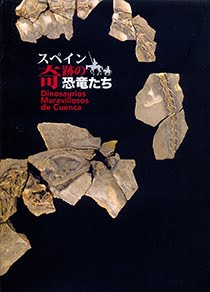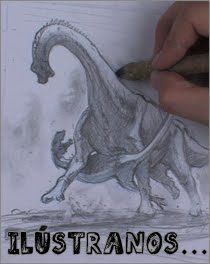En algún lugar (... Facultad de Ciencias de la Universidad Autónoma de Madrid ...) y en algún momento (... Lunes 15 de Febrero ...) Pedro Mocho defendió la memoria de tesis con título "Evolutionary History of Upper Jurassic Sauropods from the Lusitanian Basin".
Tras largos años de intensa y profunda investigación para poder entender un poco mejor cómo eran y quienes eran los grandes titanes que habitaron los ecosistemas del final del Jurásico en el territorio ibérico, Pedro Mocho obtuvo el título de doctor. El resumen es el siguiente:
Sauropod fossil record is well-represented in the Upper Jurassic of the Lusitanian Basin (Portugal). The sauropods are represented by hundreds of fossil occurrences in a sedimentary sequence ranging from the early Kimmeridgian to the late Tithonian. Four so far exclusive taxa were described: Lourinhasaurus alenquerensis, Dinheirosaurus lourinhanensis, Lusotitan atalaiensis and Zby atlanticus. In recent years, the interest about the Late Jurassic sauropods of the Lusitanian Basin has risen, and several works focused on their systematic context have been published. Nevertheless, an integrative phylogenetic approach including all sauropods from the Upper Jurassic of the Lusitanian Basin was not performed yet.
The number of so far unpublished sauropod specimens is significant, with several partial skeletons collected in the Bombarral and Turcifal Sub-basins. The analysis of this material denotes for the presence of basal eusauropods (probably turiasaurs), diplodocids (closely related to Diplodocinae), basal macronarians (including camarasaurids) and titanosauriforms (including brachiosaurids). These groups are represented from the early Kimmeridgian to the late Tithonian. This hypothesis is corroborated by the presence of four main tooth morphotypes: heart-, spatulate-, compressed cone-chisel- and pencil-shaped.
The systematic study of the classical specimens was performed, specially focused in the type material of Lourinhasaurus alenquerensis and Lusotitan atalaiensis. The reassessment of the lectotipe of Lourinhasaurus has led a detailed description and a new scoring for several morphological characters. Besides the strong similarity to Camarasaurus species, Lourinhasaurus alenquerensis is here considered a valid taxon, being characterized by 13 autapomorphies. New information is provided about the Lusotitan atalaiensis lectotype, with the reinterpretation of the previously known elements, and the description of so far undescribed elements. The validity of this taxon is confirmed, and it is proposed a revised diagnosis. Lusotitan shares with the members of Brachiosauridae the presence of dorsoventrally compressed middle caudal vertebrae, pronounced deltopectoral crest, and short ischiatic contribution to acetabulum [...].
The proposed phylogenetic analysis includes together for the first time Lourinhasaurus, Dinheirosaurus, Lusotitan and Zby, but also all the known Spanish Late Jurassic-basal Cretaceous sauropods. This phylogenetic hypothesis is based on a dataset composed by 95 taxa and 464 morphological characters. It recovers Zby as a turiasaur (the sister taxon of Turiasaurus); Dinheirosaurus and the so far unpublished specimen SHN (JJS) 177 as diplodocine diplodocids more derived than Supersaurus, Tornieria and Kaatedocus (SHN (JJS) 177 is identified as the sister taxa of Diplodocus); Lourinhasaurus as a camarasaurid (the sister taxa of Camarasaurus); Lusotitan as a brachiosaurid titanosauriform [...].
The Portuguese Late Jurassic fauna of sauropods shows some affinities with the synchronic North American fauna, sharing the presence of camarasaurids, diplodocines and brachiosaurids. Some of these taxa (Dinheirosaurus, SHN (JJS) 177 and Lourinhasaurus) are more closely related to North-American forms than to the Gondwanan ones. The closer relationship among Portuguese and North-American forms can be explained by and a more recent common history of these territories. On the other hand, Turiasauria is probably restricted to the European territory during the Late Jurassic.
La tesis ha sido dirigida por Francisco Ortega (UNED) y Rafael Royo-Torres (Fundación Conjunto Paleontológico de Teruel-Dinópolis/Museo Aragonés de Paleontología) y fue calificada con sobresaliente cum laude por los miembros del tribunal. ¡Enhorabuena Mocho!.
Fotografía, de izquierda a derecha: José Luis Sanz, Xabier Pereda, Emanuel Tschopp, Rafael Royo Torres (Codirector de la tesis), Pedro Mocho, Mario Cachão, Francisco Ortega (Codirector de la tesis), Andrea Arcucci y Jorge Morales.
------
Cita bibliográfica:
- Mocho, P. (2016). Evolutionary History of Upper Jurassic Sauropods from the Lusitanian Basin. PhD Thesis, Universidad Autónoma de Madrid.
Más información:
- "Sobresaliente para una tesis doctoral sobre dinosaurios dirigida desde Teruel" (Diario de Teruel, 17/02/2016).





























No hay comentarios:
Publicar un comentario